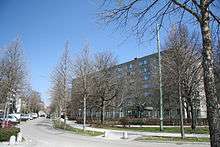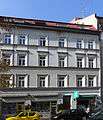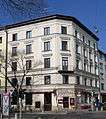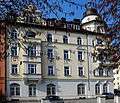Maillingerstraße
The Maillingerstraße is a street in the Munich districts Maxvorstadt and Neuhausen. In the north-south direction, it connects Nymphenburger Straße with Marsstraße. It has been named after the Bavarian general and Minister of War Joseph Maximilian von Maillinger since 1886. Today Maillingerstraße is a minimal traffic secondary road.

Historically Listed buildings
In the street, house numbers 11-13 were formerly barrack buildings.[1] At the Maillingerstraße 11, a three-story extension was built in 1979 for the payment agency for servants of the federal state of Bavaria.[2] Since 1968, the Bavarian State Office of Criminal Investigation, is located there and was built on the site of the artillery barracks,[1][3] in which a part of the listed former barracks building at Maillingerstraße 15 was integrated. This building and five other four- to five-storey apartment buildings in Maillingerstraße are historically listed buildings.[4] They refer to
- a four-storey rental house built in 1893, with a façade in late-Classicist layout at Maillinger Strasse 2,
- a built around 1890 four-story rental building as Sichtbacksteinbauweise with plaster structure in forms of Neo-Renaissance at Maillingerstraße 9,
- a five-storey rental building built in 1880 on Maillingerstraße 12 in late-Classicist style,
- a built around 1900 four-story rental building on Maillingerstraße 32, executed as a corner building with bay windows and octagonal dome, and
- a built around 1900 four-story rental building as a corner building in the style of the German Renaissance in the Maillingerstraße 34.[4]
 Maillingerstraße 2
Maillingerstraße 2 Maillingerstraße 9
Maillingerstraße 9 Maillingerstraße 12
Maillingerstraße 12 Maillingerstraße 32
Maillingerstraße 32 Maillingerstraße 34
Maillingerstraße 34
General History
The Bavarian industrialist, Georg Krauß, founded on 17 June, 1866 the locomotive factory Krauss & Comp. on the Marsfeld in Munich-Neuhausen. It was painted in 1882 by Friedrich Perlberg.[5] The factory was located at Maillingerstraße 33.[6] The newly built, in the years 1922/23, administration building was sold to the Deutsche Reichsbahn.
The composer Carl Orff, was born in 1895 in the Maillingerstraße 16[1] and lived there until October 1939.
From 1924 on, the Grünsfelder brothers owned a wholesale metal shop at Maillingerstraße 23, the former bell foundry of Ulrich Kortler (1846-1928). They emigrated to the United States during the course of Aryanization in Munich.[7]
Former areas belonging to Maillingerstraße were renamed in 1965/67 to Helmholtzstraße (the Munich ATEGE camp II in the Maillingerstraße 73 became Helmholtzstraße 15), other areas were added to the newly established Marsstraße. From 1890, the street leading from Marsstraße was first called Haslangstraße, named after the Bavarian field marshal, then from 1947, Baudrexelstraße, named after the master builder Josef Baudrexel (1861-1943). The State salary office located here held the house number 2. Which after the integration into the new building of the State Office of Criminal Investigation became Maillingerstraße 11.
In 1995, the Consulate General of the Republic of Bosnia and Herzegovina was shortly housed in Maillingerstraße 32.
Cartography
In the Munich map of the 4th edition of Meyers Konversations-Lexikon (1888), the Maillingerstraße is partially depicted. The area of today's even house numbers, 2 to 24, appears to be built on. The Munich map of the 14th edition of the Brockhaus Konversations-Lexikon (1891) shows the entire Maillingerstraße, further developed and including the locomotive factory and the infantry barracks.
Transportion history
From 21 October, 1876, the first line of Munich's horse tram from Promenade Square to later named "Burgfrieden-Maillingerstraße" in the Nymphenburger Straße, ended here, and was the precursor of the electric tram.[8]
Today's transportation connections
Near the Maillingerstraße, located on the Nymphenburger Straße is the underground station Maillingerstraße, for the U1 / U7 lines of the Munich subway, which opened on 8 May, 1983.[9][10]
References
- Christian Lankes, Wolfram Funk. "München als Garnison im 19. Jahrhundert" (in German). Mittler Verlag. Retrieved 9 February 2018.
- "Finanzminister Max Streibl preist die Datenverarbeitung". muenchen.de (in German). 29 October 1979. Retrieved 9 February 2018.
- Fritz Dillinger. "Die Geschichte des Bayerischen Landeskriminalamtes" (PDF) (in German). Polizei Bayern. Retrieved 9 February 2018.
- "Liste derBaudenkmäler" (PDF) (in German). Bayerisches Landesamt für Denkmalpflege. Retrieved 9 February 2018.
- "Locomotivfabriken Krauß & Company". bayern.landtag.de (in German). Retrieved 9 February 2018.
- "Lokomotivfabrik Krauss & Comp. AG" (in German). Albert Gieseler. Retrieved 9 February 2018.
- Wolfram Selig. "Arisierung in München" (in German). Stadtportal München. Retrieved 9 February 2018.
- "140 Jahre Tram in München!" (PDF) (in German). MVG Museum. 21 October 2016. Retrieved 9 February 2018.
- "U-Bahnhof Maillingerstraße (U1, U7)" (in German). Münchner U-Bahn. Retrieved 9 February 2018.
- "Maillingerstraße" (PDF). efa.mvv-muenchen.de (in German). Retrieved 9 February 2018.